|
MAGIC LANTERN
WORKSHOPS
PHOTO´S
CREDITS
|
|
Lichtbende offers schools, theatres, museums and community centers
special educational guidelines, workshops and an introductory lesson
that cen be taught prior to the performance.
In this introductory lesson we discuss mechanics and history of the
magic lantern and we give demonstrations of its use.
|
Info:
lichtbende@xs4all.nl
+31-6-12474941 |
|
 |
|
|
LICHTBENDE AND THE MAGIC LANTERN |
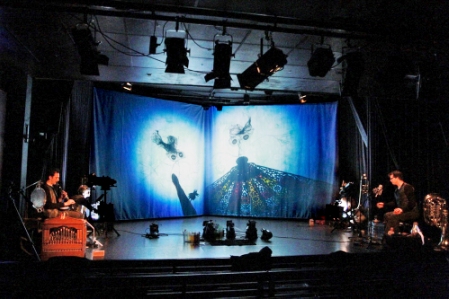 |
About
Lichtbende and the magic lantern
Theatre group Lichtbende produces magical light spectacles with
magic lanterns and
live music (without words) for everyone 4 years and up. The shows
KlikKlak, Poefff and TUTU are image concerts full of excitement,
color and joy.
A long time ago there was no film or video, no television and no
movie theatres. Back then people watched magic lantern performances
together. Lichtbende evokes this atmosphere from the old days and
lets the audience experience what such magic lantern shows were like.
This is why the magic lantern is installed right in front of the big
screen so everyone can see what the performers do with the magic
lanterns and other projectors. The result of all their actions is
enlarged and visible on the big screen.
|
|
|
|
THE
MAGIC LANTERN
Small
transparent pictures (painted on glass) or slides can be projected on a
wall using a magic lantern. We call these first projectors 'magic
lanterns' because at first the spectators didn't understand where the
colorful images on the wall came from and thus they assumed there must
be magical forces in play. A lantern that produces images out of nowhere,
it must be magic!
In a magic lantern light shines through a glass slide with a picture on
it. Behind the glass slide the light is bundled by a lens and the
picture is beamed to the wall which produces an enlargement of the
picture. We call this process projection.
A magic
lantern consists of several parts. The oldest magic lantern had a
lightsource, a lantern plate and a projection lens. A lens is made
of curved, polished glass, either in a hollow shape or in an arched
shape. This is how the light gets another direction. The light is
being bundled. Later versions of the magic lantern had more parts:
In front of the lantern plate is the projection lens. Behind the
glass slides you find another set of lenses distributing the light.
(condensor) Behind that is the lightsource. Sometimes you find a
hollow mirror behing the light source to intensify the light.
Originally the light source was a candle or an oil lamp, later a gas
flame and eventually a light bulb was used. Because the projection
lens mirrors the image in the magic lantern all the glass slides
should be injected in the magic lantern upside down, so you can see
the projection in the right way.
|
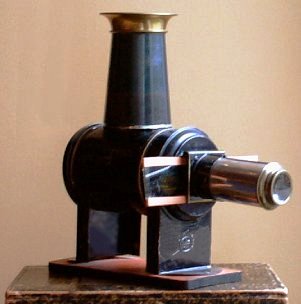
In the
"Van Dale" Dutch dictionary the translation of magic lantern is: A
device that can project enlarged images of glass painted pictures or
fotgraphic slides on a white screen or a light wall in a dark area.
Another name for magic lantern is Laterna Magica. |
|
|
|
The parts of a magic
lantern around 1900
a. the projection lens; b. the focus button (moves the lens back and
front to focus the projected image); c. filterholder (for example for
colored glass); d. coverlid (dims the light); e. condensor (distributes
the light evenly over the slide); f. chimney (exports smoke and heat
away from the oil lamp); g. side door (usually with a round, dark glass
window to keep an eye on the lamp); h. lamp (using oil, gas or
electricity); i. lampcover; j. backlid; k. ventilation shafts; l. space
for (wooden) plate holder. Many magic lanterns also have a hollow mirror
against the back that reflects the light of the lamp. |
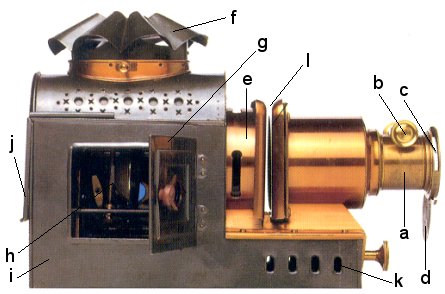
|
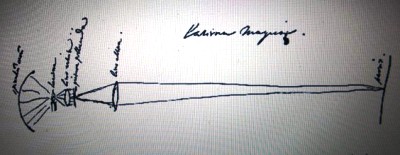 |
A
sketch of the magic lantern with 2 lenses, by Christiaan Huygens,
1694. From left to right: hollow mirror, lamp, glass lens,
transparent slide, other lens on the wall.
|
|
|
|
|
CHRISTIAAN HUYGENS, inventor of the magic lantern.
The magic lantern was invented around 1659, by the Dutch scientist
Christiaan Huygens (who lived from 1629-1695) He was a prominent
mathematician, fysicist and astronomist. He also wrote early
sciencefiction and invented many scientific instruments. From 1653 on he
experimented with lenses, microscopes and telescopes. He is one of the
most important figures in 17th century science.
In 1659
Huygens probably already used the magic lantern (he used to call it
a 'shock lantern') to entertain young and old members of the family.
In 1662 he lost all his interest and tried to escape the persistent
wishes of his dad to make him one that he could show the royal court
in Paris. 'It doesn't fit him' Christiaan writes to his brother, 'to
put up such a show in the Louvre. I am
willing though to produce for him binoculars, a microscope and
anything else he wishes, with the exception of the lantern, which
invention must be considered one of the "lost arts". He didn't think
the magic lantern fitted in with his status as a serious and
prominent scientist. At that time he would never have expected the
huge impact the lantern would eventually have, with television, film
and beamers still working according to the same principle.
|
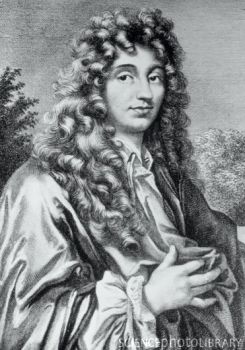
|
|
IMPORTANT
ROLE OF THE DUTCH
Several Dutchmen, in particular Christiaan Huygens, played an important
role in the 17th and 18th century in both the development of the magic
lantern and the design of (moveable) lantern plates. A friend of Huygens,
the Dutch Jesuit Andreas Taquet, must have given the first official 'magical'
show, with an audience, around that time. Other Dutch pioneers were the
brothers P. and J. van Musschenbroek and W.J. 's Gravesande. Jan van
Musschenbroek built a lifesize magic lantern in Leiden around 1720 for
Leiden's professor Willem Jacob 's Gravesande.
A couple of years later Jan van Musschenbroek made moveable plates that
were exhibited by his brother Petrus in 1731. In 1739 Petrus van
Musschenbroek described several mechanically moveable lantern plates.
Using techniques to turn, pull or lever the plates, he could move two
glass slides in front of each other and create movement (wings of a
windmill turn, a gentleman takes off his hat, a cow takes a dog on his
horns, a shoemaker moves him hammer) |
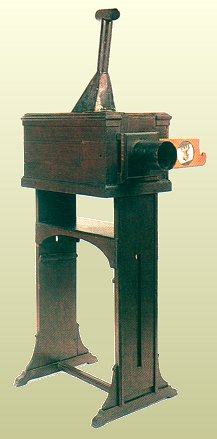 |
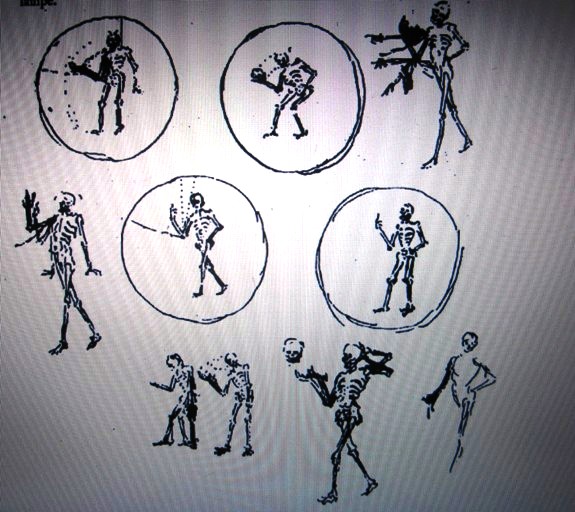 |
Above
the oldest magic lantern in the world.
The
big Magig Lantern made by Jan van Musschenbroek in 1739. Museum
Boerhaave, Leiden. |
Sketches by Christiaan Huygens: Dance of the dead, following the
example of Hans Holbein 1659. Huygens had already accomplished to
produce a simple movement effect by showing two images in a fast
sequence: he drew the skeleton that takes of his hat politely in the
next picture. This picture would later become a real classic. (Info
Museum Boerhaave)
|
|
|
|
LANTERN
SLIDES
In the time before photography glass slides with hand painted pictures
on it were used in the magic lantern. These glass slides were injected
in a wooden frame in the magic lantern. The light and the lenses in the
lantern illuminate and enlarge the picture on the wall. Later a kind of
slide with a litographic print was pressed on the glass. Often one strip
in the magic lantern showed four or five round images. Eventually this
was replaced by photography. The picture was printed directly on the
glass and after that often hand colored with waterpaint or ink.
The first
magic lanterns used weak light sources: a candle or a small oil lamp.
People found out that the pictures became more clear if the remaining
part of the glass around the images was painted black. This way the
light was blocked. At first the slides were produced by the magic
lantern player (also called the 'lanternist'). But later also the
instrument makers and optical specialists, the ones who made magic
lanterns and sold them, painted the accompanying pictures themselves.
Later this become a separate profession. Artists were trained
specifically to paint the slides at companies who received their orders
from magic lantern producers. It was a delicate task, because even the
smalles mistakes would be enlarged on the screen and therefore highly
visible. Although real artworks are among these hand painted slides, it
was rare that an artist signed his work. |
 |
|
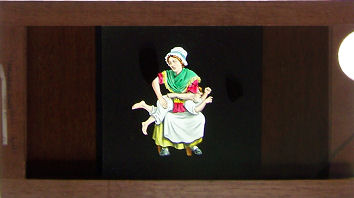 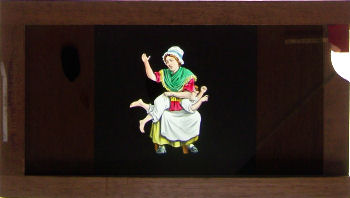 |
|
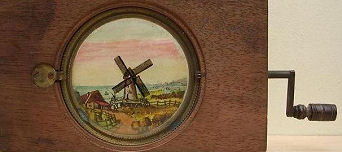 |
Above: a
single moving slide in a wooden frame picturing a mother spanking her
naughty toddler. By moving the slides back and forth movement of the arm
is created. |
|
Some
slides have moving parts. For example this single moving workslide where
a
radar makes the wings of the windmill move. |
|
|
THE
MAGIC LANTERN SHOW
After the invention of the magic lantern by Christiaan Huygens, the
magic lantern was brought to the attention of the French Sun King
(1634-1715). Christiaan Huygens' father worked at the French royal
court. The lantern was used there to entertain the king and his
family and to perform small scalle shows for the elite. Until the
second part of the 18th century the magic lantern was mainly used by
scientists. Later in the 19th century regular people could watch
magic lantern shows at the annual fair. These special shows were
performed by 'Luikerwalen', those were travelling magic lantern
players and narrators from Luik in Wallonia (Belgium). They
discovered that it was an easy way to provide information. In the
18th century illiteracy was still high among regular people. The
magic lantern was therefore used to educate in all kinds of ways.
Eventually also regular people could buy a magic lantern and hold
performances in a private circle of family and friends.
|
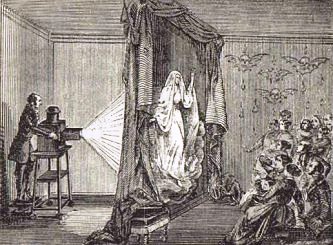 |
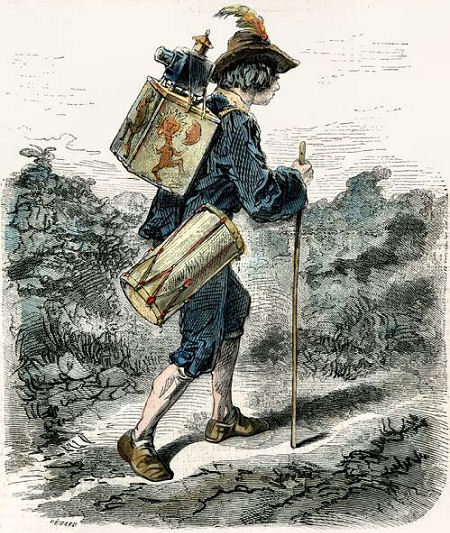 |
|
|
The
`Luikerwaal` |
LICHTBENDE AND THE MAGIC LANTERN
Lichtbende creates contemporary theatre shows with projections of
magic lanterns and live music. We don't use traditional magic
lantern slides but instead we use daily life objects and materials
like bottles, plastic cutlery, beads, buttons, yarn, bubble plastic
etc. We use these small objects of daily life to create minidolls or
other objects that we can move in the magic lantern, the slide- or
overheadprojector. Manipulating these objects is like a marionette
show but then with very small movements. Everything is projected on
a big screen bringing the figures to life the way a puppetplayer
brings his puppets to life. Music adds another layer of life; the
shows are without text. For each scene new systems and image
materials are developed. This whole process is artisanal, analogue
and low tech. In combination with the music it becomes a
cinematographic experience like in an animation or silent movie. A
world of miniscule objects is enlarged and comes to life, an antique
magic lantern reveals how much life is present in daily life
objects.
|
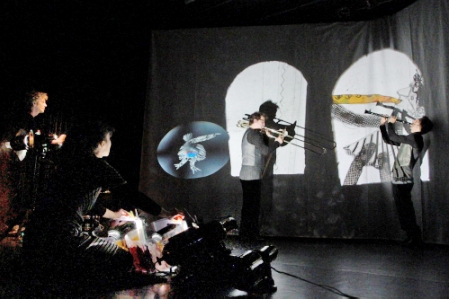 |
"During our
edcuational projects with kids in museums and schools we disovered how
exciting it is to build landscapes by using recycle materials in our
projections and to bring daily objects to life. Especially on kids'
faces we saw the wonder on their faces when they discovered that you can
create a whole castle from a candy wrapper. Our experience is that
children interpret even the most abstract projection images without any
effort and place these images in a narrative. Recognizing the materials
stimulates their fantasy and creativity and makes them want to get to
work on it themselves. This was the big incentive for us to transform
our experiences in light theatre." |
Because
the projection lens in the magic lantern mirrors the images all
figures and objects must be placed in the magic lantern upside down,
to show the projection in the right position. You can see how the
players create this world and how it is
constructed with live music and sound into a total spectacle for all
the senses where reality and dream intertwine. The story and the
images leave much room for the own imagination.
Walking the thin line between recognizable objects and abstraction
and suprising the audience with humor make the shows light and
exciting at the same time. A magical world that lets the young
audience redisover daily life in a safe and playful way.
This intimate and interactive atmosphere, the experience of live
music and the magical image-language guides the audience to a world
of wonder. You hear live tuba, trombone, clarinet, flute, saxophone
and homemade instruments. For example the rythm
of a train arriving is slowly built up with sounds of a kettle on
the fire. Lichtbende also uses small handheld magic lanterns
that are easy to move. This is an old Japanese technique. The magic
lantern landed in Japan through business routes between the two
countries, but the technical development in Japan is different from
the western one.
|
.jpg) |
|
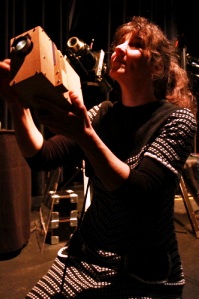 |
|
Light and
shadow theatre has a long worldwide tradition. Think of the Chinese
shadow play, Indonesian wajang dolls and Turkish shadow figures Karagoz
and Hacivat. Het is a highly accesible medium (herkenbaar klinkt gek in
het engels) that appeals to a large and diverse audience. The spectator,
regardless of age, ethnic background,
experience with art or literacy, will enjoy the show.
Lichtbende, with its image-language of daily life objects, stimulates
its audience to get to work and explore the possibilities of light- and
shadowplay (see education on this website). After the show we always
explain how the magic lantern works and we give a demonstration. |
|
|
|
SITES AND SOURCES
An educational site with
lots of information about the magic lantern is:
www.luikerwaal.com
Other
sources: Museum Boerhaave, Christiaan Huygens:
“Oeuvres
complètes”
and “Over
het oog en zien” |
 |














.jpg)
